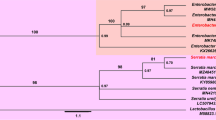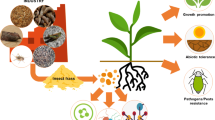Abstract
In order to develop suitable sampling methods for the arthropods of four mint species, namely Japanese mint (Mentha arvensis L.- var. Hybrid 77), peppermint (M. piperita L.-var. MP-1), bergamot mint (M. citrata Ehrhrt- var. Kiran) and spearmint (M. spicata L.- var. MSS-5), six general sampling methods viz. ground cloth, sticker, sweep net, water trap, whole plant observation (WPO) and whole plant harvest (WPH) were evaluated under field conditions at the Research Farm of Central Institute of Medicinal and Aromatic Plants, Lucknow, India. The mint pest complex on all the mint species included Aphis craccivora, Chrotogonus trachypterus, Leptocorisa varicornis, Coccinella septempunctata, Bemisia tabaci, an unidentified lygeid bug, Brumoides suturalis, Propylea dissecta, Crysolina exanthematica, Dysdercus cingulatus and Plusia orichalcea. Overall, the ground cloth, sweep net, water trap and sticker methods were found to be more efficient and successful for sampling the arthropods of mint crops than the WPO and WPH methods. The shortest sampling time was required when using the sticker (3–6 seconds per sweep) and the sweep net (7–8 seconds per sweep) methods. This information may be useful in developing an integrated pest management programme for mint.
Résumé
En vue de mettre au point des méthodes d’échantionnage appropriées pour les arthropodes de quatre espèces de menthes à savoir, la menthe japonaise (Mentha arvensis L-var. Hybride 77), la menthe poivrée (M. piperita L. - var. MP-1), la menthe bergamote (M. citrata Ehrhrt-var. Kiran) et la menthe à épi (M. spicata L.-var. MSS-5), six méthodes d’échantillonnage générales, en l’occurrence le drap au sol, le collant, le filet à balayage, le piège à eau, l’observation de la plante entière (OPE) ainsi que la récolte de la plante entière (RPE) furent évaluées dans des conditions du terrain à la Ferme de Recherche de l’Institut Central des Plantes Médicinales et Aromatiques de Lucknow en Inde. Le complexe de ravageurs de menthe trouvés sur toutes les espèces comprenait Aphis craccivora, Chrotogonus trachypterus, Leptocorisa varicornis, Coccinella septempunctata, Bemisia tabaci, une cochenille lygéide non identifiée, Brumoides saturalis, Propylea dissecta, Crysolina exanthematica, Dysdercus cingulatus et Plusia orichalcea. Dans l’ensemble, le drap au sol, le filet à balayage, le piège à eau et le collant se révélèrent plus efficients et plus fructueux dans l’échantillonnage des arthropodes que les méthodes OPE et RPE. Le collant et le filet à balayage prirent le plus court temps d’échantillonnage, soit 3 à 6 secondes et 7 à 8 secondes par prise, respectivement. Cette information scientifique peut étre utile dans la mise au point d’un programme de lutte intégrée centre les ravageurs des cultures de menthe.
Similar content being viewed by others
References
Berry R. E. and Shields E. J. (1980) Variegated cutworm: Leaf consumption and economic loss in peppermint. J. Econ. Entomol. 73, 607–608.
Chandra J. P. S. and Gulati B. C. (1969) Record of Syngamia abruptalis Heck. on Japanese mint in Tarai area. India Perf. 11, 202.
Danielson S. D. and Berry R. E. (1978) Red backed cutworm: Sequential sampling plans in peppermint. J. Econ. Entomol. 71, 323–328.
Gould E. G. (1960) Problems in the control of mint insects. J. Econ. Entomol. 53, 526–531.
Kogan M. and Herzog D. C. (1980) Sampling Methods in Soyabean Entomology. Springer-Verlag Publications, New York. 587 pp.
Liljesthron G. and Bernstein C. (1990) Density dependence and regulation in the system Nezara viridula (L) host and Trichopoda giacomellii (Blanchard) (Diptera: Tachinidae) parasitoid. Oecologia 84, 45–52.
Rao N.V., Reddy A.S., Rao B.R. and Satyanarayana G. (1991) Interplant distribution of whitefly, Bemisia tabaci Genn. on cotton, Gossypium hirsutum Linn. J. Insect Sci. 4, 32–36.
Sandhu G. S., Singh B. and Bhalla J. S. (1975) Insect pests of Japanese mint in India. Indian Perfumer 21, 13–18.
Shepard M., Carner G. R. and Tunipseed S. G. (1974) A comparison of three sampling methods for arthropods in soyabean. Environmental Entomology 3, 227–232.
Singh D. (1990) Japani podine par Lagne wale Keet Avam Unke Niyantran ki Sambhavanayen, pp. 34–35. Abstr Nat. Symp. on Paryavaran Pradushan Rahit Keet Niyantran. National Chemical Laboratory, Pune, India.
Singh D. and Bah R. (1993) New record of coccinellid predators on aphids (Aphis affinis and Myzus persicae) in Japanese mint (Mentha arvensis sub sp haplocalyx var piperascens) and egyptian henbane (Hyoscyamus muticus). Indian J. Agric. Sci. 63, 313–314.
Velasco L. R. J. and Walter G. H. (1992) Availability of different host plant species and changing abundance of the polyphagous pest Nezara viridula. Environmental Entomology 21, 751–759.
Author information
Authors and Affiliations
Rights and permissions
About this article
Cite this article
Singh, D. Development of Suitable Sampling Methods for the Arthropods of Four Mint Species. Int J Trop Insect Sci 16, 333–337 (1995). https://doi.org/10.1017/S1742758400017367
Accepted:
Published:
Issue Date:
DOI: https://doi.org/10.1017/S1742758400017367
Key Words
- mint
- Mentha arvensis
- Mentha citrata
- Mentha piperita
- Mentha spicata
- pest complex
- predator
- sampling methods




